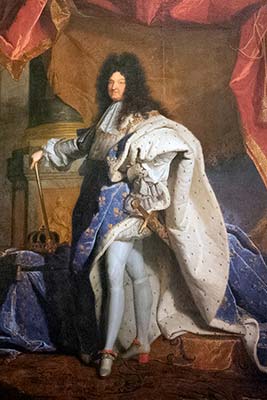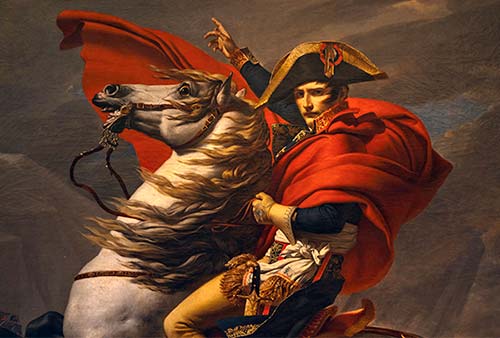
PREHISTORY, CELTS, AND ROMANS (15,000 BC-AD 500)
Map: French History & Art Timeline
PEAK OF POWER—RENAISSANCE KINGS, LOUIS XIV, REVOLUTION (1500-1800)
BUDDING DEMOCRACY AND THE BELLE EPOQUE (1800s)
CULTURE CAPITAL AND WORLD WARS (1900-1950)
POSTWAR AND INTO THE 21ST CENTURY (1950-Present)
From quaint medieval villages to Impressionist paintings to wine-soaked vineyards, the charm of today’s France was forged in its history.
Back when woolly mammoths still roamed the earth, France gave Europe its first sightseeing wonders: stunningly realistic cave paintings of animals, by the surprisingly sophisticated Cro-Magnon people of 15,000 thousand years ago.
France entered recorded history around 50 BC, when Julius Caesar conquered the indigenous Celtic tribes (called Gauls). For the next 500 years, this Gallo-Roman region (with its capital at Lyon) would be an integral part of the Romans’ Europe-wide empire.
The ingenious Romans left a legacy of huge structures—aqueducts, temples, triumphal arches—that still impress visitors today. The mix of Latin and Celtic cultures came to define the French character.
• Cluny Museum (Roman baths)
• Louvre (Roman antiquities)
• Paris Archaeological Crypt
Around AD 500, Roman France fell to the Germanic Franks (hence “France”), and later to the Viking Norsemen (of “Norman”-dy, ninth century).
France shattered into countless small dukedoms, each with its own rulers and customs. These distinct regions live on today in Aquitaine, Burgundy, Languedoc, and so on. This is the bouillabaisse of cultures that would eventually cook up into “France.”
In 507, the Christian ruler Clovis established a loose association of Frankish tribes. By 800, Charlemagne had created a large Frankish empire, giving a glimpse of the nascent nation-state to come.
In 1066, the Norman duke William the Conqueror invaded England, merging the two countries into an awkward Anglo-French empire. It would take the next three centuries to sort out who ruled what.
• Cluny Museum (artifacts and stained glass)
• Statue of Charlemagne (in front of Notre-Dame)
France came into its own as a European power during the Age of Faith, when the Christian church dominated life. France became Europe’s monastic center, where learned monks pioneered cutting-edge technology like forges, water mills, and wine- and cheesemaking.
With religious power came political influence. By 1200, the Cluny Abbey—with 25 acres, 10,000 monks, and 1,000 franchise monasteries across Europe—rivaled the papacy as the center of Christianity. The Abbey of Fontenay further spread France’s influence. Throughout France, pilgrimage sites hummed with visitors who came to adore the Virgin Mary in churches dedicated to Our Lady, or “Notre Dame.”
France pioneered two groundbreaking architectural styles: Romanesque churches featured barrel-arched ceilings, while Gothic churches had soaring pointed arches and stained glass.
Meanwhile, France was struggling with medieval strife. In the 1200s, a crusade was launched to root out a heretical French sect called the Cathars...leaving only ghostly castle ruins in its wake. Then came the brutal Hundred Years War (1328-1453) between French and English armies. Rallied by the teenage visionary Joan of Arc, the French finally drove the English across the Channel.
As it emerged from the war, France rebuilt and came into its own. Burgundy’s sophisticated dukes financed colorfully tiled buildings and progressive hospitals. Rich merchant towns like Colmar produced great art. Avignon became the center of Christendom (1309-1417), when a series of French-aligned popes left Rome to make their home here. French kings annexed formerly independent regions into a powerful nation state.
• Notre-Dame Cathedral
• Sainte-Chapelle
• Cluny Museum (tapestries)
• Carnavalet Museum
• Sorbonne
• Latin Quarter
By 1500, France had become strong, prosperous, and united. A series of enlightened Renaissance kings were setting Europe’s standard. They turned the Loire Valley into their weekend retreat, building glorified hunting lodges (châteaux) in evocative settings.
François I (1494-1547) made France a cultural magnet, inviting the great Leonardo da Vinci (and his Mona Lisa) to visit. When François’ son married Catherine de Medici (the great-granddaughter of Lorenzo the Magnificent), she brought the Italian Renaissance with her, making Italian-style art and architecture all the rage.
Henry IV (1553-1610, the first Bourbon ruler) steered the country through its tumultuous religious wars (against Protestant Huguenots) and renovated Paris.
By 1650, France was Europe’s superpower, led by a charismatic ruler who fancied himself as divinely ordained—Louis XIV (1638-1715). Louis neutered the parliament and turned France into a humming nation-state. For the next century, his lavish palace of Versailles was the center of European power and high culture.
Louis XIV’s successors—Louis XV, Louis XVI, and Queen Marie-Antoinette—were less capable and more decadent. Meanwhile, enlightened French thinkers like Voltaire, Moliere, and Rousseau were planting the seeds of democracy...and revolution was in the air.
On July 14, 1789, French citizens stormed the Bastille. Eventually the king and queen were toppled and thousands of others were guillotined if they hindered the French Revolution’s progress. Angry revolutionaries ransacked all symbols of the Old Regime, from palaces to once-powerful abbeys.
Amid the chaos, a charismatic commoner promising stability rose to power: Napoleon Bonaparte. With France’s mighty armies, Napoleon conquered much of Europe, spreading revolutionary values, until he was finally defeated at Waterloo...and France entered the modern age.

• Renaissance and Religious Wars: Louvre, Hôtel de Ville, Pont Neuf, Place des Vosges, Fontainebleau
• Louix XIV: Versailles and Vaux-le-Vicomte, Hôtel des Invalides
• Revolution: Place de la Concorde and Place de la Bastille, Conciergerie, Carnavalet Museum, Champs-Elysées, Panthéon
Though the French monarchy was temporarily restored, rulers now had to toe the democratic line or face popular uprisings (in 1830 and 1848). The longing for freedom—both political and personal—was expressed in dramatic Romantic style paintings.
France was modernizing. Rundown Notre-Dame and Revolution-damaged châteaux were restored. Canals laced the country together, to transport bulky materials (and, later, well-fed tourists).
By 1850, France’s president was Napoleon’s nephew, known as Napoleon III. He presided over a wealthy, middle-class nation enriched by a lucrative colonial empire. Then in 1870, France was shocked awake by a disastrous defeat at the hands of the Germans in the Franco-Prussian War. Almost overnight, France began its political decline.
Nevertheless, the late 1800s were a high-water mark for France as a cultural superpower. This was the belle époque—the “beautiful age”—a prosperous time of shimmering Impressionist canvases, elegant department stores, cancan dancers, and the futuristic Eiffel Tower.
• Arc de Triomphe
• Baron Haussmann’s wide boulevards
• Eiffel Tower
• Carnavalet Museum
• Pont Alexandre III
• Grand Palais and Petit Palais
• Montmartre
• Opéra Garnier
• Impressionism at the Musée d’Orsay, Orangerie, and Musée Marmottan
• Rodin Museum
France entered the 20th century with great optimism, but two world wars with Germany wasted the country. World War I, fought largely on French soil, devolved into a horrific stalemate of muddy trench warfare, machine guns, and chemical weapons. France lost 1.3 million souls and was left traumatized.
But, as it emerged from the war, France remained a cultural force, attracting talented foreigners from Picasso to Hemingway. Travelers still flocked to the Riviera’s elegant old hotels, Monaco casino, and alpine resorts (Chamonix hosted the 1924 Olympics).
When World War II erupted (1939), France was easily overrun, and soon Nazis were goose-stepping down the Champs-Elysées. France was split into Occupied France (in the north) and Vichy France (the south, ruled by Nazi sympathizers). Some 200,000 French were deported to concentration camps, never to return.
The war went underground with the legendary French Resistance. Daring fighters cut Nazi phone lines, bakers hid radios in loaves of bread, and housewives spread battle news along with neighborhood gossip.
Meanwhile, the Allies (US, UK) were pecking away at the fringes to liberate Europe. France became the staging area for a history-changing moment. June 6, 1944—D-Day—saw the largest amphibious military operation in history. On France’s north coast, 180,000 Allied soldiers stormed the beaches, established a beachhead, and began the final push to end the war.
France was devastated...but free.
• Army Museum
• Picasso Museum
• Montmartre
• Deportation Memorial and Holocaust Memorial
• Pompidou Center (art from this period)
Even as France recovered from World War II, its colonial empire was dissolving in bitter conflicts in Algeria and Vietnam. In 1958, wartime hero Charles de Gaulle was tapped to govern.
Prosperity returned, but the country was changing. Immigrants from former colonies sought better circumstances in France. There were turbulent student riots in the 1960s, progressive social experiments in the 1970s, socialism turning to conservatism in the 1980s, and the middle-of-the-road 1990s. France became a global innovator with its high-tech TGV trains, modern architecture, and urban renewal.
Through it all, France was a driving force in Europe’s great social experiment: creating the European Union. Strasbourg, home to the EU Parliament, became second only to Brussels as a capital of international Eurocrats. France entered the 21st century ready to take on its global challenges.
• Montparnasse Tower
• La Défense
• Louvre’s pyramid
• Pompidou Center (modern art)
• Army Museum (Charles de Gaulle exhibit)
Today, France is a prosperous cultural force on the world stage, working to navigate global changes while maintaining its strong national identity—its “Frenchness.”
Economically, France is one of Earth’s top ten. It enjoys a well-educated workforce, an especially robust service sector, and a high-end manufacturing industry (including a major stake in Airbus). On the other hand, its budget deficits and unemployment are persistently high.
France’s challenge is to address its economic problems while maintaining the cradle-to-grave social services the French expect. Ironically, while the French want the creature comforts of a consumer economy, they remain skeptical about the virtues of capitalism. Many French believe the economy should support social good, not vice versa. Workers routinely assert their rights through protests and strikes.
Business conversation outside the office is generally avoided. It’s considered gauche even to ask what someone does for a living (in part because they think there’s much more to a person than their occupation). In France, CEOs are not celebrities—chefs are.
As an essential member of the EU and NATO, France is a strong global player, though not nearly the superpower it once was. France still exerts influence in its former colonial empire in Africa and helped broker the Paris Climate Accords. But with globalization, many French fear losing what makes their society unique. While the French government is perennially pro-EU, many ordinary French remain Euroskeptics.
Similarly, immigration is challenging the national identity. Ten percent of French people have North African and Muslim roots, sometimes clashing with France’s Christian and secular traditions. Debates continue over, say, whether banning the full, face-covering Muslim veil enforces democracy—or squelches diversity. Unemployment is high in immigrant neighborhoods, where protests against systemic racism and biased policing have become violent riots. And terrorist attacks by Islamic extremists have shaken the country. It all raises serious questions about how well the country assimilates its immigrants, and what it means to be French.
In politics, rather than two dominant political parties, France has many—from far-left to far-right. Since no single party ever gets a majority, compromise and coalition-building are essential. The 21st century alone has seen the political pendulum swing dramatically, from left (President Jacques Chirac) to right (Nicolas Sarkozy) and back to left (Francois Hollande). President Emmanuel Macron has charted a centrist course: pro-EU and pro-business while still trying to appeal to the average Jean.
Despite France’s challenges, the irrepressible spirit of liberté, égalité, fraternité (and love of stinky cheeses) continue to bind the nation together. There’s a thriving universe of uniquely French cinema, books, and pop music. Everyone comes together to celebrate World Cup victories, the Olympics, and the Tour de France. As France speeds deeper into the 21st century, its “Frenchness” remains strong.
For more about French history, consider Europe 101: History and Art for the Traveler by Rick Steves and Gene Openshaw, available at RickSteves.com.